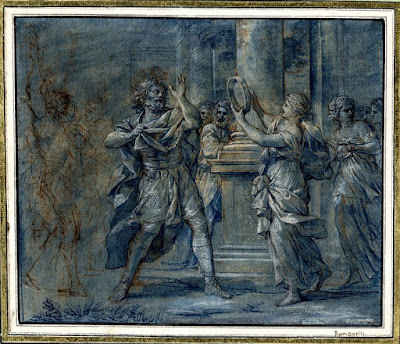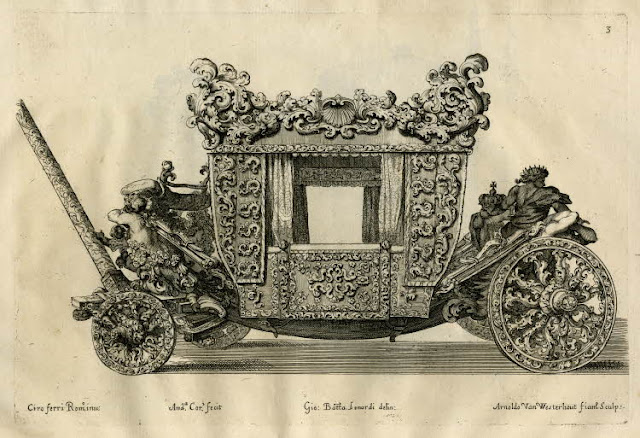 |
| Giovanni Francesco Romanelli Figure of Time in clouds with scythe before 1662 drawing British Museum |
Both Giovanni Francesco Romanelli (1610-1662) and Ciro Ferri (1634-1685) were steady workers, producing a reliable supply of beautiful pictures – according to prevailing aesthetic expectations – in mid-century Rome. They were favored collaborators of Pietro da Cortona, pre-eminent hero-painter of the Roman High Baroque.
 |
| Giovanni Francesco Romanelli Sacrifice of Iphigenia before 1662 drawing Teylers Museum, Haarlem |
 |
| Giovanni Francesco Romanelli Meeting of Ariadne and Bacchus before 1662 drawing British Museum |
 |
| Giovanni Francesco Romanelli Juno entrusting Io (as cow) to Argus before 1662 drawing British Museum |
 |
| Giovanni Francesco Romanelli Wedding of Peleus and Thetis ca. 1637-40 drawing Teylers Museum, Haarlem |
How was this marriage arranged? Old Proteus had said to Thetis,
'You need to conceive a child, wave-goddess; you're destined to bear
a hero who, grown to his prime, shall challenge the deeds of his father
and merit a mightier name.' Now Jupiter hotly desired
fair Thetis, but could he allow the world to contain a being
more mighty than him? He couldn't; and so, to avoid a union
with Nereus' daughter, he ordered his grandson Peleus to woo her
in place of himself and take the maid of the sea to his bosom.
Picture a sickle-shaped bay on Thessaly's coast, with it arms
jutting out like the ends of a bow. If the water inside it were deeper,
there'd be a harbor; but only a film of sea spreads over
the top of the sand. The shore is so firm that it shows no footprints,
it's easy to walk on and isn't bestrewn with squelching seaweed.
Nearby is a coppice of myrtles, laden with black and green berries.
There, in its heart, imagine a grotto, which could be natural
or artificial, more likely the latter; and this is where Thetis,
riding her bridled dolphin, would often arrive quite naked.
One day she was lying there fast asleep, when Peleus surprised her
as ordered, and then, since she wouldn't respond to his wooing entreaties,
he clasped her neck in his amorous arms and attempted to rape her.
His boldness would have succeeded if Thetis hadn't made use
of the magical skills she possessed and kept on changing her shape.
She took the form of a bird, but he still held on to the bird.
She changed to a sturdy tree, and he clung to the trunk like ivy.
She next adopted the shape of a black-striped tigress; at last
her assailant, in terror, relaxed the hold of his arms on her body.
Peleus next appealed to the sea-gods, pouring wine
on the waves and offering entrails of sheep with smoking incense,
until the Carpathian prophet, Proteus, rose from the depths
and said to him, "Aeacus' son, you shall win the bride you are seeking.
All you must do is to catch her asleep in the rocky cave
and trap her unconscious limbs in the tangling snare of a rope.
Don't let her elude you by falsely assuming a hundred disguises.
Just squeeze her firmly until she returns to her normal shape."
When Proteus had given this counsel, he plunged his face in the sea,
and his native waves closed over his head on his final words.
Titan the sun god was sinking and guiding his chariot downwards
into the western waves as the beautiful Nereid, Thetis,
left her home in the water and went to her usual bedroom.
Peleus hardly had time to entrap the nymph in his noose
when she started to take new shapes, until she saw she was tightly
gripped, with her arms stretched out on either side of her body.
At last she gave in, as she sighed, "You win! Some god must be helping you."
– from Book 11 of Ovid's Metamorphoses, translated by David Raeburn (2004)
 |
| Giovanni Francesco Romanelli Returning home, Jephthah encounters his daughter before 1662 drawing British Museum |
 |
| design by Ciro Ferri drawing by Giovanni Battista Lenardi print by Arnold van Westerhout Roger Earl of Castlemaine's coach for entry into Rome as Ambassador 1687 etching British Museum |
The two etched views of Lord Castelmaine's florid coach were created for publication as plates in a book by John Michael Wright, published first in Rome in 1687 and then in London in 1688. It described the lengthy formalities and many splendors involved in welcoming the representative of King James II in 1686, the first such official sent to Rome from England since 1570. This new friendliness proved unsustainable. By the time the book was published in London and the etchings became available for admiration, the Catholic King James was in process of being deposed and sent out of the country.
 |
| design by Ciro Ferri drawing by Giovanni Battista Lenardi print by Arnold van Westerhout Roger Earl of Castlemaine's coach for entry into Rome as Ambassador 1687 etching British Museum |
 |
| Ciro Ferri Victorious warrior (ornament design for the back of a coach) ca. 1683-85 drawing Royal Collection, Windsor |
 |
| Ciro Ferri Design for decorative object of unknown purpose before 1689 drawing British Museum |
 |
| Ciro Ferri Moses striking the rock ca. 1670-80 drawing (print study) Royal Collection, Windsor |
 |
| Ciro Ferri St Teresa kneeling before effigy of Infant Christ ca. 1655 drawing (print study) British Museum |
 |
| after Ciro Ferri River landscape with washerwomen 17th century drawing (copy of a painting, now lost) British Museum |
 |
| Ciro Ferri Académie before 1689 drawing British Museum |
"This is a typical example of an 'academy', that is, a finished study from the male nude carried out as an end in itself and not preparatory to any picture or sculpture. The name derives from an artist's academy (or studio) where such life classes were generally held for the instruction of beginners in drawing."
"The traditional attribution to Pietro da Cortona was questioned by Walter Vitzthum, who, in a note on the mount, gave the drawing to Ferri. Good comparisons may be made with some of Ferri's autograph works, e.g. the 'Half-length Figure of a Satyr' in the Ratjen Collection, Munich, which is drawn in a similar technique of black and white chalk on tinted paper. On the other hand, the simple strength in the handling of the landscape background and of the cloak seems so entirely characteristic of Cortona himself, that it was tempting to return the drawing to his name. A certain hardness in the modeling of the flesh and the rather mechanical cross-hatching (which is hardly ever encountered in Cortona's drawings of academies) nevertheless point more in the direction of Ferri."
– commentary by Nicolas Turner from Italian Drawings in the British Museum: Roman Baroque Drawings (British Museum, 1999)